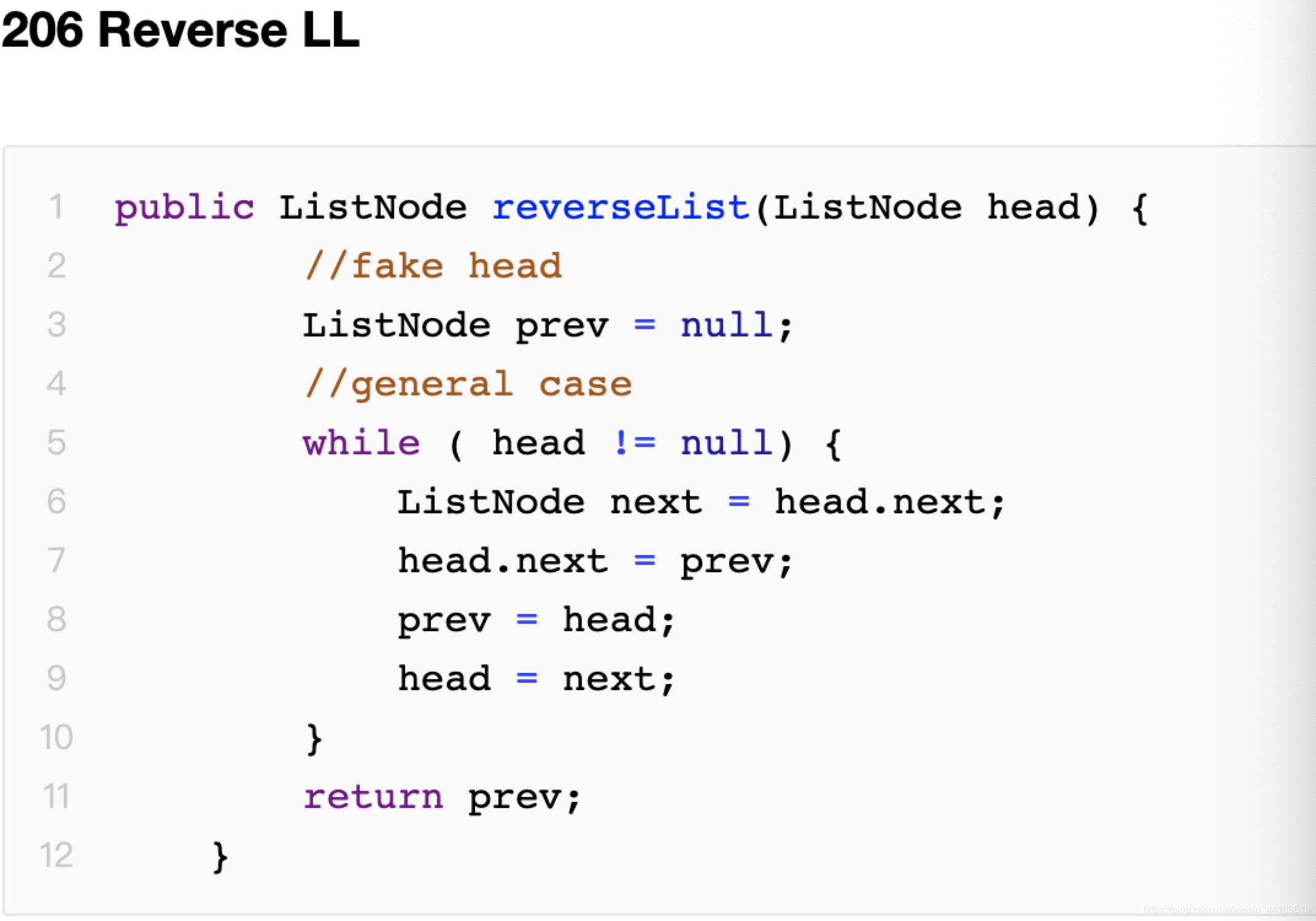leetcode刷题--链表
一、 参考链接
参考文章:https://blog.csdn.net/qq_35580883/article/details/79061578
二、理论
三、leetcode刷题
1. reverse linkedlist(反转链表)–206
由于链表会断开,因此在反转链表之前,先记录下一个节点的元素信息。
头节点反过来指向null。


class Solution {
public ListNode reverseList(ListNode head) {
ListNode node = head;
ListNode newNode = null;
ListNode nextNode = null;
while(node != null){
nextNode = node.next;
node.next = newNode;
newNode = node;
node = nextNode;
}
return newNode;
}
}
2. remove linkedlist element(移除链表元素)—203
创造一个虚拟的头节点,这样可以不用考虑head问题。
ListNode dummy = new ListNode(0);
dummy.next = head;


递归:

3. Linkedlist Cycle(判断链表环)—141

如果链表有环,快慢指针一定会相遇。
4. remove Nth node from end of list(删除链表倒数第i个元素)—19


class Solution {
public ListNode removeNthFromEnd(ListNode head, int n) {
ListNode dummy = new ListNode(0);
dummy.next = head;
ListNode ToEnd = dummy;
ListNode ToTarget = dummy;
ListNode preNode = null;
int count = 0;
while(ToEnd.next !=null){
if(count < (n-1)){
ToEnd = ToEnd.next;
count++;
}
if(count == n-1){
ToEnd = ToEnd.next;
preNode = ToTarget;
ToTarget = ToTarget.next;
}
}
preNode.next = ToTarget.next;
return dummy.next;
}
}
5. 链表相交 —160
/**
* Definition for singly-linked list.
* public class ListNode {
* int val;
* ListNode next;
* ListNode(int x) {
* val = x;
* next = null;
* }
* }
*/
public ListNode getIntersectionNode(ListNode headA, ListNode headB) {
int lena = 0;
int lenb = 0;
ListNode tempa = headA;
ListNode tempb = headB;
while(tempa != null){
lena++;
tempa = tempa.next;
}
while(tempb != null){
lenb++;
tempb = tempb.next;
}
tempa = headA;
tempb = headB;
if(lena > lenb){
for (int i = 0; i < lena-lenb; i++) {
tempa = tempa.next;
}
}
else{
for (int i = 0; i < lenb-lena; i++) {
tempb = tempb.next;
}
}
while(tempa != null && tempb != null && tempa.val != tempb.val){
tempa = tempa.next;
tempb = tempb.next;
}
return tempa;
}
四、扩展(链表的基本操作)
1.插入:(2种)
1)一种最简单,每个节点插入链表的头部:
private static void insertBackward(Node node) { node.next = head;
head = node;
outputNode();
}
2)还有一种插入是插入链表尾部:即每次插入都遍历到链表尾部插入
private static void insertForward(Node node) {
if (node == null) {
return;
}
if (head == null) {
head = node;
} else {
Node cur = head;
while (cur.next != null) {
cur = cur.next;
}
cur.next = node;
}
outputNode();
}
2.链表查找: 遍历链表,找到对应的值返回即可
public static Node find(Object object) {
if (object == null) {
return null;
}
Node current = first;
while (current != null) {
if (current.value == object) {
return current;
}
current = current.next;
}
return null;
}
3.链表删除:遍历链表,让链表的前一个节点指向需要删除的节点的下一个节点即可
public static Node delete(Object object) {
if (object == null) {
return null;
}
Node pre = first;
Node current = first.next;
if (first.value == object) {
first = first.next;
return first;
}
while (current != null) {
if (current.value == object) {
pre.next = current.next;
first = pre;
return first;
}
pre = current;
current = current.next;
}
return null;
}
熟悉了链表的基本操作,对链表的扩展也就很简单了。
五、链表反转思路讲解
由于链表的特性,链表的翻转需要一点点思考。
一般的逻辑就是遍历到最后一个节点,然后把前面的放在最后一个节点之后。但是问题就出现了:遍历到最后一个节点之后如何获取前面的节点呢?有人说我把这个节点复制一遍!这样就会增加不必要的空间消耗,不是很好的解决办法。
其实我们在遍历的过程中可以把每个节点存起来!
比如我们有一个链表:1 2
- currentNode = 1(2);(括号里是后面的节点)
- nextNode = currentNode.next = 2;
- 想要执行链表的翻转:把currentNode存到nextNode的next里就行了:nexNode.next = currentNode ---- > 2 1 2
我们看到上面的链表其实没有完成翻转,因为节点1的后面还有个节点2,多了一个节点,为什么会这样呢?因为currentNode.next也有值啊。
- 所以我们需要在翻转之前把currentNode的next的值删除:currentNode.next = null;
- 然后再进行翻转:nexNode.next = currentNode ---- > 2 1 null
public Node reverseNode(Node current) {
//用next指向current的下一个节点
Node nextNode = current.next;
//将current的下一个节点置为null,这样这个节点就只有一个节点了
current.next = null;
//把当前节点放在nextNode节点之后,完成节点翻转
nextNode.next = current;
return nextNode;
}
上面这段代码很容易就完成了两个节点的翻转,那如果有多个节点呢?我们需要使用递归,假如我们写的方法是:
Node reverseLink(Node current)
我们进行如下过程模拟:
假如有链表:1 2 3 4 5
按照上面的步骤:
- Node currentNode = 1(2 3 4 5) 当前节点
- Node nextNode = currentNode.next = 2(3 4 5) 下一个节点
- currentNode.next = null 当前节点之后的都删除,防止链表多余
执行到这里我们应该怎么操作呢?假如我们完成翻转:
- nextNode.next = currentNode – > nextNode = 2 (1)
可以看出这样我们就失去了后面的节点。所以我们应该在翻转操作完成之前就进行递归,并把nextNode当做当前节点传到方法里:
- 利用递归 Node reverseNode = reverseLink(nextNode),继续执行我们刚才的步骤。那要递归到什么时候为止呢?当然是得到最后一个节点:
if (currentNode.next == null) {
return currentNode;
}
也就是说当我们遍历到最后一个节点的时候,reverseNode = nextNode;此时nextNode = 5, currentNode = 4;
翻转可得: nextNode.next = currentNode = 5(4),也就是reverseNode = 5(4),此时相当于把反转过的节点放在了reverseNode中了。所以最后返回reverseNode即可。
由于currentNode和nextNode都是方法里的局部变量,所以会保存我们每一次递归的当前节点currentNode和下一个节点nextNode,而最后reverseNode保存已经反转过的链表。
当然是利用递归啦!从上面代码可以看出,翻转的真正的点在于能得到前一个节点并能保存当前节点,这样即使遍历到最后一个节点完成翻转之后还能回来继续翻转。
以上过程写成代码为:
public Node reverseLink(Node current) {
//遍历到最后一个节点直接返回
if (current.next == null) {
return currentNode;
}
//用next指向current的下一个节点
Node nextNode = current.next;
//将current的下一个节点置为null,这样这个节点就只有一个节点了
current.next = null;
//当前节点已经保存current中,递归nextNode,一直到最后一个节点
Node reverseNode = reverseLink(nextNode);
//把当前节点放在nextNode节点之后,完成节点翻转
nextNode.next = current;
//翻转之后的链表都存在reverseNode中,所以最后返回它就可以
return reverseNode;
}
链表翻转递归的思想就是:遍历链表并保存当前的节点和前一个节点,每次翻转两个节点之后返回继续翻转
可是面试官的套路是,但凡能让你用递归完成的算法,都会让你用非递归方式再完成一次:
如何用非递归方式完成链表翻转呢?其实非递归的方式涉及当前节点的保存,下一个节点的保存和下一个节点之后的链表保存,因为如果不保存下一个节点之后的链表,翻转之后就会丢失后面的节点,这一点前面我们已经讨论过了。所以非递归代码如下:
private static void reverseNoRecursive() {
Node pre = null;
while (head != null) {
Node t = head.next;
head.next = pre;
pre = head;
head = t;
}
head = pre;
}
至此链表的翻转已经讲完了。






















 722
722











 被折叠的 条评论
为什么被折叠?
被折叠的 条评论
为什么被折叠?








